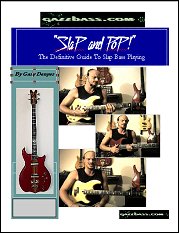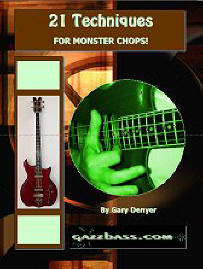
|
 |
|

Guitar Center Now Ships
Internationally
to over 90 countries! |
|
 |
|
 |
|
 |
|
|
 |

|
Bassline Breakdown
CORONET, WOOLWICH SOLO BY MARK KING - PART 2
|
|
In 1983, Level 42 bass maestro Mark King would pen a slap solo piece that would be synonymous with his name for the rest of his career. This piece was first made available to the mass populous on the "Live - A Physical Presence" album, where it featured just before the start of the song "Love Games", played live in Coronet, Woolwich, March 1985. The solo has been played live by Mark time and time again, each time giving us a different variation of the piece.
The "Live - A Physical Presence" starts with Marks' already famous "Dune Tune", the subject for another Breakdown! perhaps. The piece we're interested in for this edition is the slap piece of the solo.
(Note: It is advisable that you read my lesson on Slap Triplets before you continue. This Breakdown! also assumes that the player has a solid slap foundation. If you wish to learn slap bass in detail, allow me to plug my DVD "SlaP and PoP!").
First Part - 1st Two Bars
The first two bars of the second part of this solo serve to tell the listener that a new phrasing is about to begin. In other words, it it somewhat like a bridge in a song. It is similar to the previous parts, but different enough to add another dimension to the solo. It is performed thus:
Loading the player ...
Open E-string slap, muted E-string slap, dead string pop on G-string, 4th - 5th Fret A-String hammer-on, one muted note slap on E-string, one dead string pop on G and one open E slap.
(Note: this following technique is a bounce technique producing three notes in quick succession on the E-String)
Two muted note slaps on E-string followed by one open E slap, one hammer-on mute with fret hand and a 7th Fret G-string pop
Two muted note slaps on E-string followed by one open E slap, one hammer-on mute with fret hand and a 9th Fret G-string pop
Muted E-string slap, dead string pop on G-string, 9th - 11th Fret A-string hammer on, 9th Fret G-string pop, two muted E-string slaps, 7th Fret G-string pop, 6th Fret G-string pop... finish with two open E-string slaps.
The part above constitutes one bar. To finish this first part, repeat the above pattern. This pattern may me difficult to follow to start with, so make full use of the tab/notation and video clip in order to get the correct rhythm. (Note: the tab/notation omits the first three notes explained above, since they are part of the previous bar. Please look at the full tab/notation at the bottom of the page for reference).
Second Part - Eight Bars Of Triplet / Mute Slap Combos
This part of the solo is perhaps the most difficult to control. It consists of an intricate pattern of triplets (see lesson) and E-string muted notes. I shall describe the notes below, but for reference, its essential for you to check the tab/notation and video clip for timing the piece.
Loading the player ...
One open E-string slap followed by three bounced (see above) muted E-string slaps.
Three triplets using G-string pops... first triplet 7th Fret G-String pop, second triplet 6th Fret G-String pop, third triplet 7th Fret G-String pop.
Follow up with one muted E-string slap, two open E-string slaps and one more muted E-string slap, using the fret hand to mute rhythmically (see video clip).
Two triplets using G-string pops... first triplet 6th Fret G-String pop, second triplet 7th Fret G-String pop... follow up with one muted E-string slap, two open E-string slaps and one more muted E-string slap.
Two triplets using G-string pops... first triplet 6th Fret G-String pop, second triplet 7th Fret G-String pop.
One muted E-string slap, one dead string pop on the G-string, 9th - 11th Fret A-string hammer on, 9th Fret G-string pop, one open E-string slap.
Repeat this part four times!! This may take some practice to perfect, but once you're there, we'll be ready to join the first two pieces together.
Third Part - Join First Part and Second Part Together
The secret to joining these parts together is to pick a tempo that you are absolutely comfortable with in playing the first part. If you start off too fast with the first part, you will run into trouble when trying to keep up playing the second part triplet/muted slap combos.
Loading the player ...
Remember, its not a race! Play very slowly and pick up speed as your technique improves. If you are a beginner / intermediate player, take plenty of time to study slap techniques. Be patient and persevere... you WILL get there if you desire it enough!
Fourth Part - Join "Coronet Part 1" And "Coronet Part 2" Together!
All things worthwhile are also usually hard to attain. That's what makes reaching these goals all the more satisfying! Take it easy and slow... once you have mastered these pieces at a slow pace, begin to crank up the tempo. Increase speed in small increments. This will help you to remain confident about achieving your goals.
Loading the player ...
The final video is played at a conservative pace for clarity. To see it at a faster pace, visit the bass videos section of the website, under the JayDee section!
Finally...
I hope you enjoyed this edition of "Breakdown!". I'll be back soon with another bass line!
|
|
|
Download
Breakdown Package!
|
|
Go Back
To Breakdown! Home |
|
|
|
|
 |
|
|
Slap And Pop! DVD
|

|
|
By
Gary Denyer
|
| |
|
This comprehensive GAZZBASS.COM DVD SET, "SlaP And PoP" chronicles the bass guitar, its history, and the techniques of slap bass playing. A must for the beginner or intermediate, and a great reference work for the advanced, "SlaP And PoP" is both a musical journey and a teaching tool for all the budding slappers out there...
|
|
Learn
More...
|
|
|
|
21 Techniques For Monster Chops
|

|
|
By
Gary Denyer
|
| |
|
"21 Techniques For Monster Chops!" is a vastly revised and immeasurably more informative version of our online slap bass mini course! Due to an enormous amount of requests and questions, we've produced this all-inclusive DVD! With 7 extra techniques and a book full of tab, notation and explanations...
|
|
Learn
More...
|
|
|
|
| |
|